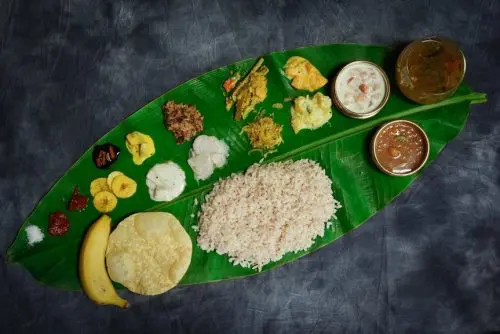
Onam Food is at the heart of Kerala‘s grandest festival, a vibrant and joyous celebration that transcends religious boundaries and unites the people of the state in a spirit of togetherness.
The essence of Onam is captured not only in the elaborate rituals and the majestic Pookalam (floral carpet) but also in the sumptuous Onam Food Specials that bring together a variety of flavours and aromas, each dish steeped in tradition and history.
Onam, the grandest festival of Kerala marks the return of the mythical King Mahabali, whose reign is considered a golden era of prosperity and equality. The festival, observed with great enthusiasm and fervour, is a blend of cultural events, traditional games, and, most importantly, a gastronomic feast that brings together a variety of flavours and aromas, each dish steeped in tradition and history.
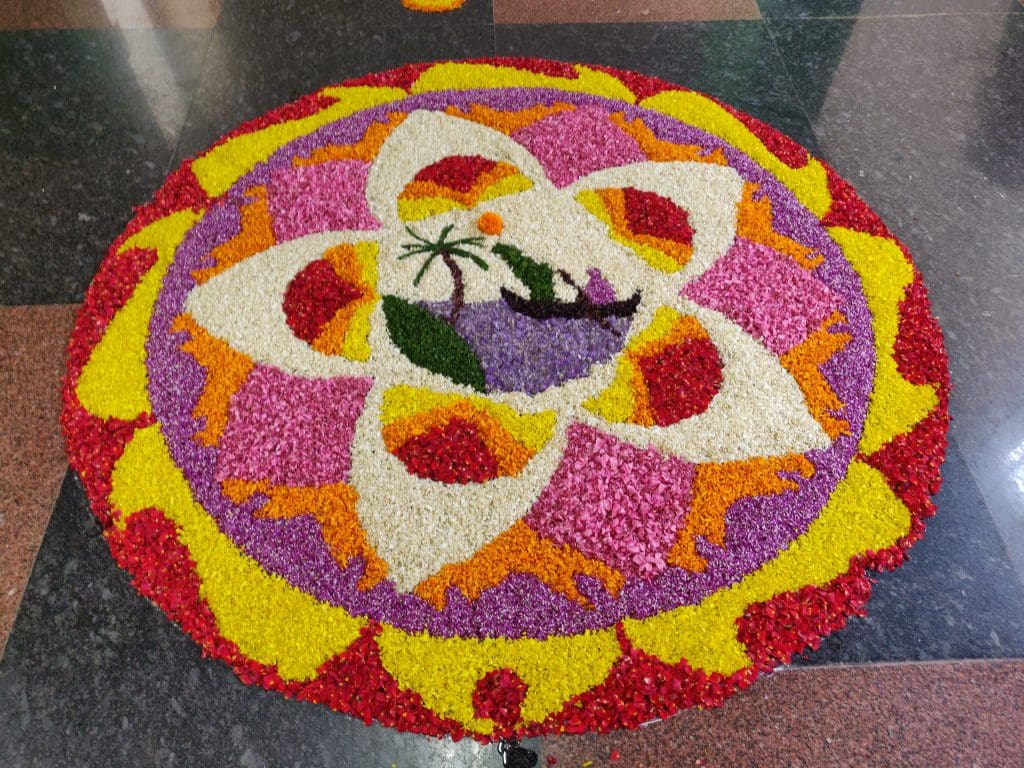
The essence of Onam is captured not only in the elaborate rituals and the majestic Pookalam (floral carpet) but also in the sumptuous feast known as the Onam Sadhya. This grand meal is the highlight of the festival, featuring an array of dishes that reflect the rich culinary heritage of Kerala. Each dish, whether vegetarian or non-vegetarian, carries with it a story, a tradition, and a flavour that is deeply connected to the cultural identity of the region.
The Significance of Onam and the Onam Sadhya
Onam is typically celebrated in the Malayalam month of Chingam, which usually falls between August and September. The ten-day-long festival, culminating on Thiruvonam, is a time for family reunions, joyous celebrations, and, of course, indulgence in the Onam Sadhya. The Sadhya is a symbol of the prosperity and abundance that King Mahabali’s reign represented. It is a generally vegetarian feast that is traditionally served on a banana leaf and includes a wide variety of dishes, each with its unique flavour and texture. The Sadhya is not just a meal but an experience that encapsulates the spirit of celebration that is Onam.
The Culinary Masterpieces of Onam
While the Onam Sadhya is traditionally a vegetarian spread, the festival also sees the preparation of several non-vegetarian dishes that are cherished by many. These dishes, though not a part of the Sadhya, hold a special place in the culinary landscape of Kerala and are enjoyed during the Onam celebrations.
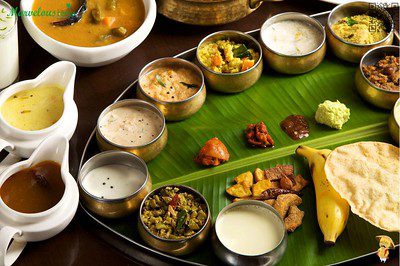
Nadan Kozhi Curry: A Spicy Chicken Delight
Nadan Kozhi Curry is a bold and flavorful chicken curry that is a favourite among Keralites. The dish is known for its rich gravy, which is a perfect blend of spices, coconut milk, and fresh herbs. The term ‘Nadan’ translates to ‘country’ or ‘traditional,’ reflecting the authentic preparation style of this dish. The chicken is slow-cooked to perfection, allowing the spices to seep into the meat, creating a dish that is both aromatic and deeply satisfying. Nadan Kozhi Curry is often served with rice or traditional Kerala bread like appam or parotta, making it a comforting and hearty dish that complements the festive spirit of Onam.
Malabar Mutton Biryani: The Aromatic Jewel of Kerala
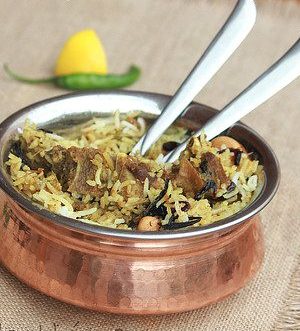
The Malabar Mutton Biryani is a dish that exemplifies the culinary excellence of the Malabar region of Kerala. This biryani is distinct from its counterparts in other parts of India, primarily due to the use of short-grained, fragrant rice called Kaima or Jeerakasala and the unique blend of spices that give it a subtle yet rich flavour. The mutton is marinated in a mix of yoghurt and spices, then cooked until tender, and layered with the aromatic rice.
The dish is garnished with fried onions, raisins, and cashews, adding a touch of sweetness to the spicy, flavorful biryani. Malabar Mutton Biryani is often served with a side of raita and pickle, making it a complete meal that is both luxurious and satisfying, fitting perfectly into the festive celebrations of Onam.
Meen Mulakittathu: The Fiery Fish Curry
Meen Mulakittathu is a fiery red fish curry that is a staple in the coastal regions of Kerala. The dish is known for its bold flavours, achieved by using a generous amount of red chilli powder, tamarind, and fresh coconut oil. The fish, usually mackerel or sardine, is cooked in a tangy, spicy gravy that is both mouth-watering and addictive. Meen Mulakittathu is often paired with steamed rice or kappa (tapioca), creating a meal that is simple yet bursting with flavour. This dish is a reflection of Kerala’s rich coastal heritage and is a must-try for those who love spicy, tangy flavours.
Avial: The Quintessential Vegetarian Dish
Avial is one of the most iconic dishes of Kerala and a star of the Onam Sadhya. This dish is a medley of vegetables like yam, carrots, beans, and raw bananas, cooked in a coconut-based gravy seasoned with curry leaves and coconut oil. What makes Avial unique is the use of yoghurt or tamarind as a souring agent, which gives the dish a subtle tanginess that balances the sweetness of the vegetables. Avial is often referred to as the ‘king of vegetarian dishes’ in Kerala and is an essential part of the Sadhya, symbolizing the diversity and richness of the harvest.
Kootu Curry: A Nutty, Spicy Delight
Kootu Curry is another essential dish in the Onam Sadhya, known for its unique combination of flavours and textures. The dish is made with a mix of vegetables and black chickpeas, cooked in a coconut-based gravy with a generous amount of grated coconut and roasted spices. The addition of fried coconut pieces adds a crunchy texture, while the tempering of mustard seeds, dried red chillies, and curry leaves enhances the aroma and flavour of the dish. Kootu Curry is a dish that embodies the essence of Kerala’s vegetarian cuisine, with its perfect balance of spices, sweetness, and texture.
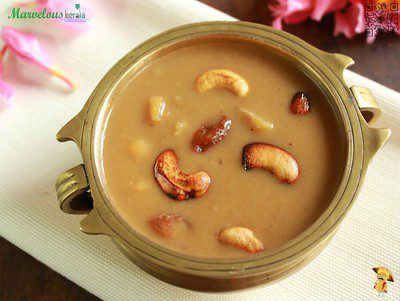
Palada Payasam: The Sweet Finale
No Onam Sadhya is complete without a serving of Palada Payasam, a traditional rice pudding that is loved by all. This dessert is made by slowly cooking rice flakes (ada) in milk and sugar until it reaches a creamy consistency. The addition of cardamom and ghee gives the payasam its distinctive flavour and aroma. Palada Payasam is often garnished with fried cashews and raisins, adding a touch of richness to the dish. This sweet, creamy dessert is the perfect way to end the grand Onam feast, leaving a lingering taste of sweetness that complements the elaborate meal.
Elaneer Payasam: A Refreshing Coconut Dessert
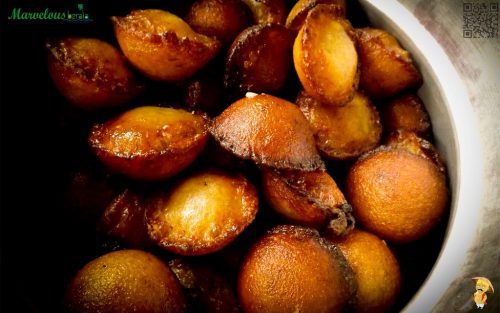
Elaneer Payasam, also known as tender coconut payasam, is a light and refreshing dessert that has become increasingly popular during Onam. The dish is made with tender coconut water, coconut milk, and jaggery, resulting in a delicately sweet and creamy pudding. The addition of tender coconut pieces adds a delightful texture, while the subtle flavour of cardamom enhances the overall taste. Elaneer Payasam is a perfect dessert for those who prefer a lighter, less rich sweet dish, offering a refreshing end to the elaborate Sadhya.
Erissery: A Sweet and Savoury Delicacy
Erissery is a unique dish that combines the sweetness of pumpkin with the savoury flavours of roasted coconut and spices. This dish is made by cooking pumpkin and cowpeas in a coconut-based gravy, seasoned with cumin, turmeric, and green chillies. The highlight of Erissery is the topping of roasted coconut, which adds a rich, nutty flavour to the dish. Erissery is a popular dish in the Onam Sadhya and is often served alongside other vegetarian dishes, adding a sweet and savoury element to the meal.
Olan: A Delicate Coconut Milk Stew
Olan is a simple yet flavorful dish made with ash gourd and cowpeas, cooked in coconut milk and seasoned with curry leaves and coconut oil. The dish is known for its delicate flavours, with the sweetness of the coconut milk perfectly balancing the mild taste of the vegetables. Olan is a dish that embodies the simplicity and elegance of Kerala cuisine, making it a must-have in the Onam Sadhya.
Inji Puli: A Tangy Ginger-Tamarind Relish
Inji Puli, also known as Puli Inji, is a tangy and spicy relish made with ginger, tamarind, and jaggery. This dish is a perfect accompaniment to the rich and flavorful dishes of the Sadhya, as it provides a refreshing contrast with its sharp, tangy taste. Inji Puli is a staple in the Onam Sadhya, adding a burst of flavour that complements the elaborate meal.
Madhura Curry: The Sweet and Spicy Balance
Madhura Curry is a dish that perfectly balances sweet and spicy flavours, making it a unique addition to the Onam Sadhya. This dish is made with ripe plantains and grated coconut, cooked with a mix of spices that include mustard seeds, curry leaves, and green chillies. The sweetness of the plantains, combined with the heat from the chillies and the nuttiness of the coconut, creates a dish that is both comforting and flavorful.
Kurukku Kalan: The Creamy Yogurt Curry
Kurukku Kalan is a thick, creamy curry made with yoghurt, raw banana, and yam, seasoned with black pepper, turmeric, and coconut paste. This dish is known for its tangy and spicy flavours, with the yoghurt providing a refreshing contrast to the heat of the black pepper. Kurukku Kalan is a quintessential part of the Onam Sadhya, offering a rich and creamy dish that balances the diverse flavours of the meal.
The Cultural Connotations of Onam Dishes
Each dish served during Onam is more than just a culinary delight; it carries with it the cultural and historical significance of Kerala. The Onam Sadhya, in particular, is a reflection of the region’s agricultural abundance and the diversity of its produce. The use of seasonal vegetables, fresh coconut, and spices in these dishes symbolizes the harvest season, which is central to the celebration of Onam.
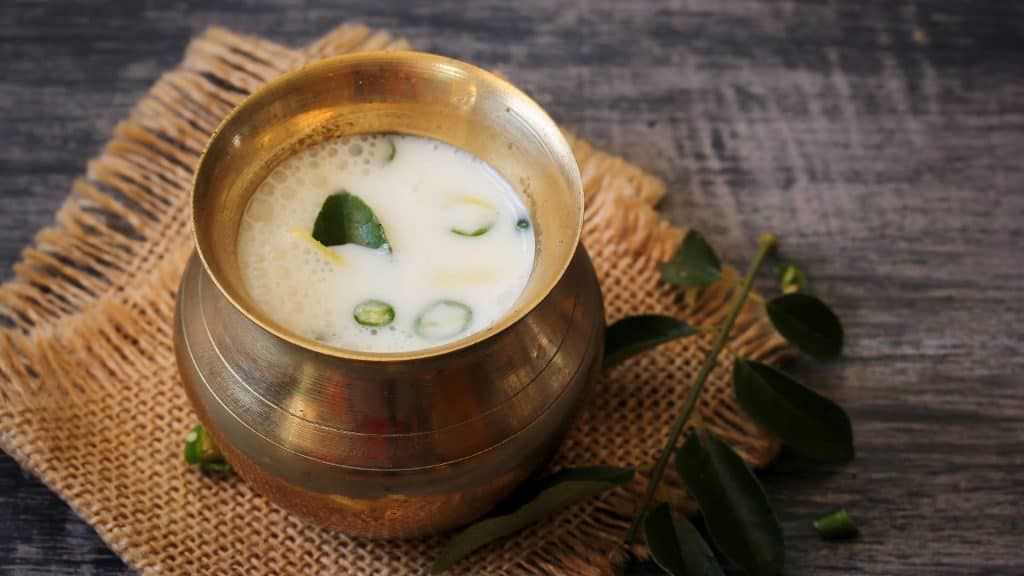
The vegetarian dishes of the Sadhya, such as Avial, Kootu Curry, and Olan, represent the simplicity and purity of nature’s bounty, while the rich, creamy desserts like Palada Payasam and Elaneer Payasam are a celebration of sweetness and prosperity. The non-vegetarian dishes, though not part of the traditional Sadhya, highlight the diversity of Kerala’s culinary traditions, with each dish offering a unique flavour that is deeply rooted in the local culture.
Onam – A Feast for the Senses
Onam is not just a festival; it is a celebration of life, nature, and the rich cultural heritage of Kerala. The elaborate feast, the Onam Sadhya, is a true reflection of this celebration, with each dish offering a unique taste of Kerala’s culinary excellence. Whether it is the bold flavors of Nadan Kozhi Curry, the aromatic charm of Malabar Mutton Biryani, or the timeless classics like Avial and Kootu Curry, the dishes of Onam are a feast for the senses, transporting you to the heart of Kerala with every bite.
As families come together to celebrate this festival of abundance, the Onam Sadhya serves as a reminder of the prosperity, unity, and joy that King Mahabali’s reign symbolized, making it a meal that is truly fit for a king.
Lesser-known facts about the famous Onam Sadya
- Symbolic Number of Dishes: Traditionally includes up to 26 dishes, representing abundance and prosperity.
- No Onion or Garlic: Prepared without these ingredients to align with Ayurvedic sattvic (pure) food practices.
- Significance of the Banana Leaf: The meal is served on a banana leaf with antibacterial properties, placed with the narrow end to the left.
- Order of Serving: Each dish has a specific place on the leaf, starting with salt and a small banana.
- Payasam Variety: Multiple types of payasams can be served, each with unique ingredients and preparation.
- Rice Varieties: Kerala Matta rice, known for its reddish-brown colour and rich nutrients, is typically used.
- Cultural Etiquette: The meal is eaten with hands, and the way the banana leaf is folded after the meal conveys satisfaction or dissatisfaction.
- Communal Preparation: The Sadya is often prepared communally, fostering unity and togetherness.
Read More: Latest



